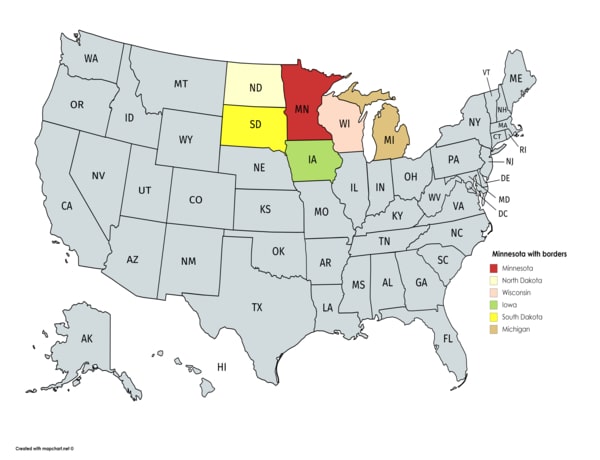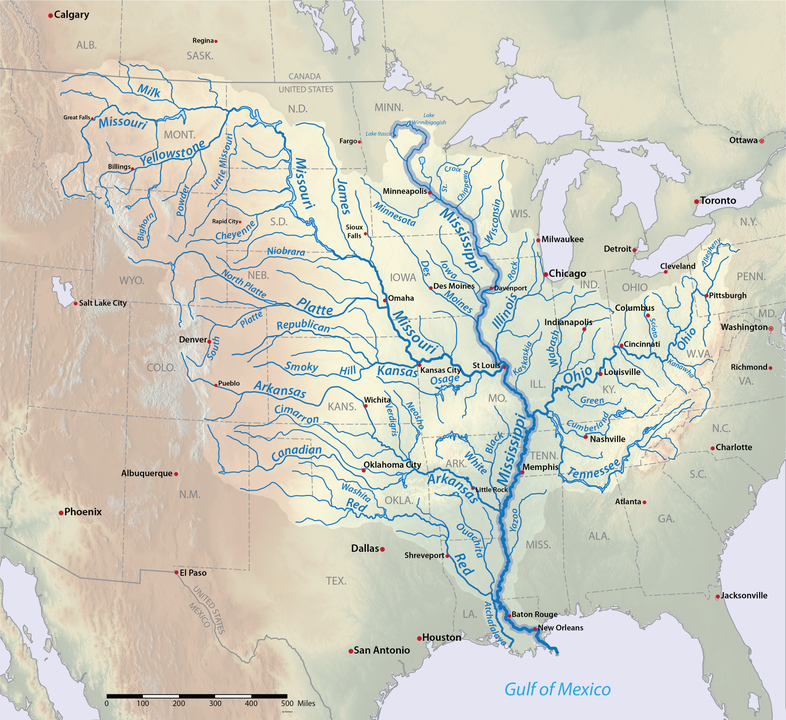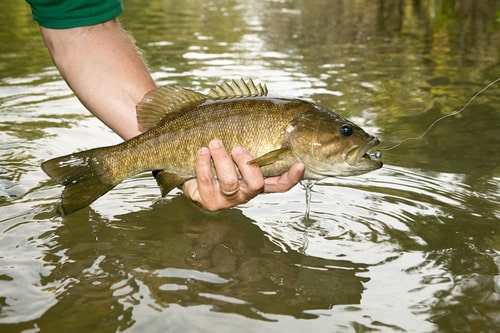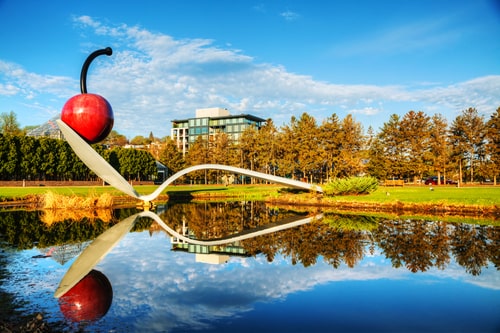Last updated on May 9th, 2024
Minnesota is the 22nd most populous and the 12th most extensive of the 50 states of the United States. It lies in the Upper Midwest, Great Lakes and northern regions of the United States. The state attained statehood on May 11, 1858, becoming the 32nd state to join the union. It shares its border with five states Iowa, Michigan (water border), North Dakota, South Dakota, and Wisconsin. Minnesota (nicknamed: Gopher State, Land of 10,000 Lakes, North Star State, State of Hockey) has 87 counties. The state’s capital is Saint Paul. The postal abbreviation for Minnesota is MN. With these facts about MN, let us learn about its history, economy, geography, people, culture, wildlife, and nature.
Facts about Minnesota
1. First settlers
The oldest human remains found in the region date back to 7,000 BC. These remains were found in 1933 near Browns Valley, east of the state of Minnesota; hence, the name of Man of Browns Valley. Human presence in the region could be before the date thanks to the discovery.
2. The arrival of the Europeans
French nationals, Pierre Esprit Radisson and Médard Chouart were, in 1660, the first inhabitants of the old continent. In 1679, French explorer Daniel Greysolon claimed the entire region on behalf of France. French influence in the area declined after 1763 when France ceded part of Minnesota to the United Kingdom.

3. The Dakota tribe
In the period when the first European explorers arrived in Minnesota, the region was inhabited by the Dakota tribe. Other tribes, such as the Ojibwa (also called Chippewa or Anishinaabe) began emigrating to the west of the state around 1700. The economy of these tribes was based mainly on hunting and gathering.
4. Largest Somali populations
Minnesota boasts one of the largest Somali populations in the U.S., estimated at over 100,000 residents, adding significant cultural diversity to the state. This community has enriched Minnesota’s social fabric, bringing unique traditions and perspectives that contribute to the state’s multicultural richness.
5. Lutherans
Another interesting fact about Minnesota is that it has the largest number of Lutherans in the country.

6. Great museums
Minnesota is home to several museums that you cannot ignore. They are mainly located in the city of Minneapolis and the list includes – the Walker Art Center, which is dedicated to visual art. The center was founded in 1940 and it is ranked in the top five contemporary art museums of the United States. It attracts more than 700,000 visitors a year.
7. “A Timeless Tapestry of Cree Designs and Natural Harmony”
Dating to 1929, the Naniboujou Lodge on Lake Superior’s North Shore showcases vibrant Cree designs, creating a unique architectural marvel. Each corner of the lodge tells a story, inviting visitors into a living museum where history, art, and nature harmonize in a captivating blend of cultural heritage and natural beauty.
8. “The Wizard of Oz.”
Grand Rapids, Minnesota, proudly claims itself as the birthplace of Judy Garland, famed for her role as Dorothy in “The Wizard of Oz.” The town hosts a dedicated museum showcasing Garland’s life and legacy through exhibits, making it a must-visit destination for her fans.
Minnesota on the map
9. “Star of the North”
Minnesota is the most northerly of all the states (reaching lat. 49°23’55″N), except for Alaska. The state’s motto is L’Etoile du Nord, which in French means “Star of the North.”
10. Impact of ice on the state’s landscape
Sheets of ice masses transformed the landscape. The glaciation was last seen thousands of years ago. These glaciers affected wide areas except the southeast. This is an area that has countless steep hills, including streams that hit the rocky bed.
11. The highest natural point in Minnesota
At 701 meters (2,301 feet), Eagle Mountain stands tall as Minnesota’s highest point. The mountain is located in Northern County and is a Minnesota State Historic Site.
12. The Iron Range in northern Minnesota
The roots of the volcanic mountains worked in conjunction with the Precambrian seas to create the Iron Range, which located in the northern parts of Minnesota. After a period of volcanic activity 1.1 million years ago, the geological activity of Minnesota has been more moderate, without volcano eruptions or the formation of mountains.
13. The Drift less Area
It is home to the Drift less Area, which is known for the lack of glacial drift. About 12,000 years ago, the expansive Lake Agassiz was created in the northern areas. The lake’s exit, the Warren River Glacier, played a role in the formations of the Minnesota River Valley.
14. The first tornado
The first recorded tornado in the U.S. happened in Minnesota in 1856.

15. Roots of the mighty Mississippi
The world-famous Mississippi river begins in the Northern part of Minnesota. Its roots can be traced to the Lake Itasca.
16. “The Land of Triple Origins”
It is also the only state with the source of three main rivers – the Mississippi, the St. Lawrence and the Red River of the North.

17. The longest cave
Mystery Cave, the longest cave in the State of Minnesota is located in Forestville State Park and is open to the public. The interesting thing is to observe its natural formations of stalactites, stalagmites and underground pools. It is perfectly conditioned for tourism and even children can enter.
18. The largest lakes
To the north, you will find the largest lakes in Minnesota and the headwaters of the Mississippi River. Lake Leech is the third-largest in Minnesota. It is worth visiting, especially for its landscape. It has an irregular shape in addition to small and large bays.
19. Lakes and mosquitoes
Minnesota is often humorously called the “Land of 10,000 Lakes and 10 Million Mosquitoes” due to its abundance of water bodies and mosquitoes.
20. “Icebox of the Nation,”
International Falls, Minnesota, aptly named the “Icebox of the Nation,” experiences some of the coldest winter temperatures in the contiguous United States, often dropping below freezing, with lows reaching as cold as -40°F (-40°C).
21. “Underground Tales”
The Wabasha Street Caves in St. Paul, Minnesota, are legendary for their intriguing history, once serving as secretive meeting places during the Prohibition era. Spanning extensive sandstone cliffs along the Mississippi River, these caves have hosted notorious figures like John Dillinger, adding to their mystique.
22. Expansive state parks
Minnesota state parks occupy more than 200 thousand hectares. Many of its lakes and rivers allow locals and visitors to enjoy various activities, including sailing, fishing, boating, swimming and walking on foot through forests, marshes, grasslands, rivers, and lakes.
23. The historic Forestville Park
At the historic Forestville Park, which has been restored with a 19th-century appearance, you can view the wildlife, including glacial snails and wooden rattlesnakes. Other species also include deer, beavers, bison, coyotes, foxes and at least 175 different species of birds.
24. “Magnetic Rock: Nature’s Enigma”
Magnetic Rock stands as a natural marvel, captivating adventurers and geologists alike. It is nestled within the vast expanse of the Boundary Waters Canoe Area Wilderness (an area of about 1.1 million acres in the Superior National Forest).
This substantial boulder, boasting magnetic properties, not only captures the imagination but also poses a unique challenge to explorers, as its magnetic force can interfere with compasses, adding an element of mystery to the wilderness experience.
25. Minnesota Zoo
The Minnesota Zoo is located near Minneapolis and Saint Paul and has 4,990 animals and 533 species in an area of 485 hectares. This large space makes animals feel as if they are in their respective habitats. The zoo operates as a place to connect people with animals. The zoo opened to the public in May 1978.
26. The largest population of gray wolves
The region has the largest population of gray wolves outside of Alaska. It is also home to considerable populations of elk and white-tailed deer. The state has populations of waterfowl, such as geese and ducks as well as other migratory birds, such as Uruguayans, pheasants, and turkeys. To the southeast, you can find brook trout, common trout, and rainbow trout.
27. The largest population of bald eagles
Minnesota, especially around the Mississippi River, hosts one of the largest population of bald eagles (9800 pairs) in the United States, reaching into the thousands during winter.

28. The best smallmouth bass
Lake Mille Lacs is home to the best smallmouth fish. It has been reported that some weigh up to a little more than three kilograms.
29. “Sail and Explore: Minnesota’s Aquatic Wonderland”
The land of 10,000 lakes has more recreational boats per capita than any other state.
30. The largest amusement park
Valleyfair is the largest amusement park in the Midwest area of the United States. It has over 75 rides and attractions including eight roller coasters. There is also an area called “Route 76” dedicated to the classic attractions with which the park originally started in 1976.
31. Top ranking in education
Practically since its creation as a state of the Union, Minnesota has paid special attention to education. MN is proudly one of the ten strongest states in education.
32. World’s first open heart operation
The world’s first open heart operation was performed in the University of Minnesota in 1952 by surgeon Dr. C Walton Lillehei. Lillehei has been called the “King of Hearts” for his pioneering research as a surgeon and inventor of medical devices.
33. Pioneering a New Era in Healthcare
Founded in 1957, Minnesota marked a significant milestone in healthcare by establishing HealthPartners, one of the pioneering health maintenance organizations (HMOs) in the United States.
34. The first successful bone marrow transplant
Dr. Robert A. Good, a Minnesota physician, performed the first successful bone marrow transplant in 1968 at the University of Minnesota Medical Center.

35. “Mayo Clinic: A Legacy of Healing and Innovation Since 1889”
The Mayo Clinic is an American non-profit academic medical center based in Rochester, Minnesota. The facility employs more than 60,000 staff people including scientists, physicians, administrators and allied health staff. Surgery at Mayo Clinic began with the frontier practice of Dr. William Worrall Mayo, who moved to Rochester in 1863. It has become a global medical hub renowned for ground-breaking research and exceptional patient care.
36. Cancer research center
Founded in Austin, Minnesota, the Hormel Institute has been at the forefront of cancer research since its establishment. Renowned for its cutting-edge work, this leading institution has been pioneering advancements in cancer studies since 1942, offering new hope to patients worldwide.

37. Number one ranking for fitness
The state of Minnesota ranks first when it comes to the percentage of residents who exercise regularly. It is second in three key indices: low infant mortality, long life expectancy, and a low mortality rate.
38. Health plus beauty
No wonder, Minnesota is considered to be one of the healthiest and most peaceful states in the entire Union.

39. The largest network of skyways
Another interesting fact about Minnesota is that the Minneapolis Skyway System stands out as the largest network of skyways globally. It links 80 blocks contiguously for a distance of up to 9.5 miles. The very first skyway, opened in 1962. People can move one building to another in a more convenient way even during bad weather.

40. World’s largest ball of twine
In Darwin, Minnesota, a remarkable sight awaits: the world’s largest ball of twine, meticulously crafted by a single person and weighing over 17,000 pounds.
41. The oldest and largest State Fair in the U.S.
The Minnesota State Fair, among the oldest and largest in the U.S., annually attracts millions of visitors. This grand celebration of agriculture and culture unites people in a vibrant food, entertainment, and community spectacle.
42. Oldest rocks on earth
The gopher state has some of the oldest rocks found on earth that were formed about 3.6 billion years ago. About 2.7 billion years ago, basaltic lava sprouted from cracks in the ground of the primitive ocean. The remains of this volcanic rock formed the Canadian Shield in northeastern Minnesota.
43. World’s largest free-standing hockey stick
Eveleth, Minnesota, proudly hosts the world’s largest free-standing hockey stick over 100 feet tall. This colossal symbol of the town’s hockey passion attracts visitors, reflecting Eveleth’s deep-rooted love for the sport.

44. The largest urban sculpture gardens
One key fact about Minnesota is that the Minneapolis Sculpture Garden is the largest in the United States. The facility occupies 4.5 hectares (11-acre) and boasts 40 permanent installations. Some of the pieces are moved in and out of the park periodically.
45. “The World’s Largest Muskie Sculpture”
In Hayward, Wisconsin, near the Minnesota border, stands the world’s largest fiberglass sculpture of a Muskie fish. This impressive tribute to the region’s fishing culture measures an astounding 143 feet in length.
46. World’s Largest Raspberry statue
Hopkins, Minnesota, proudly hosts the World’s Largest Raspberry statue, a vibrant tribute to the city’s raspberry farming heritage. This colorful landmark stands 22′ tall, symbolizing Hopkins’ agricultural legacy and attracting visitors with its impressive size and local pride.
47. The largest free-standing planetarium globally
The William J. Kendrick Planetarium, located within the Mayo Clinic in Rochester, Minnesota, is the largest free-standing planetarium globally, offering a captivating astronomical experience. Opened in 1960, it combines cutting-edge technology and immersive displays to inspire wonder and curiosity about the universe.
48. “A Tale of Progress and Innovation Beyond the IDS Center’s 40-Year Reign”
For over 40 years, the IDS Center graced Minneapolis as the tallest building in Minnesota until 2019. Its dominance in the skyline symbolized the city’s progress, but as newer skyscrapers emerged, Minneapolis underwent a transformative architectural shift, reflecting its commitment to innovation and urban development.
49. “The Majestic Legacy of Split Rock Lighthouse”
Perched dramatically on Lake Superior’s North Shore cliffs, Split Rock Lighthouse is one of the most photographed in the United States. Built in response to a tragic 1905 storm, it is a testament to maritime history, guiding ships safely through the lake’s challenging waters.
50. The world’s largest pelican
The state is home to the world’s largest pelican, which was erected at base of the Mill Pond dam. The concrete statue, which was built in 1957, is situated in Pelican Rapids. It is a towering tribute to the town’s avian namesake. This colossal sculpture stands tall, drawing visitors to marvel at its grandeur and artistic significance in the heart of Minnesota.
51. Pioneering Preservation Before Minnesota’s Statehood
The Grand Portage National Monument predates the state, as it was established in 1951, eight years before Minnesota became a state.
52. “Bemidji’s Timeless Marvels”
Bemidji, Minnesota, features iconic statues of Paul Bunyan and Babe the Blue Ox, crafted in 1937. These towering sculptures capture the spirit of American folklore, drawing visitors into the fantastical world of the legendary lumberjack and his faithful companion.
. . . continue reading on the next page
